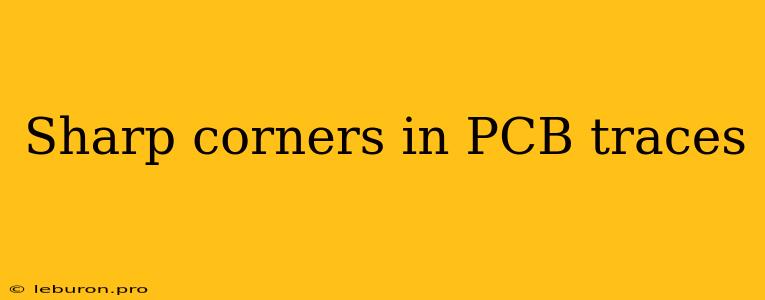In the intricate world of printed circuit boards (PCBs), where electronic components are interconnected through meticulously crafted copper traces, sharp corners pose a significant challenge to signal integrity. These seemingly innocuous features can introduce detrimental effects that impact the performance, reliability, and overall functionality of electronic devices. Understanding the implications of sharp corners in PCB traces is crucial for designers and engineers to optimize their layouts and ensure optimal signal transmission.
The Perils of Sharp Corners
Sharp corners in PCB traces act as impedance discontinuities, disrupting the smooth flow of electrical signals. This disruption arises from the abrupt change in the trace's geometry, which alters the characteristic impedance of the transmission line. The impedance mismatch at these corners creates reflections, where a portion of the signal is reflected back towards the source instead of propagating forward. These reflections can interfere with the intended signal, causing distortion, signal degradation, and potential data errors.
Impact on Signal Integrity
The presence of sharp corners can significantly impact signal integrity in several ways:
- Increased Signal Attenuation: Reflections at sharp corners cause a portion of the signal energy to be reflected back, reducing the signal strength that reaches the destination. This attenuation can lead to signal loss and decreased signal-to-noise ratio (SNR).
- Signal Distortion and Timing Errors: Reflections can introduce unwanted oscillations and ringing, distorting the original signal shape. These distortions can lead to timing errors and data corruption, particularly in high-speed digital applications.
- Increased EMI/EMC Issues: Sharp corners can act as antennas, radiating unwanted electromagnetic interference (EMI) and contributing to electromagnetic compatibility (EMC) problems.
- Power Loss and Increased Heat Generation: Reflections can result in power loss, leading to increased heat generation in the PCB. This can affect the reliability and lifespan of components.
Mitigating the Effects of Sharp Corners
Fortunately, there are several design techniques and fabrication processes that can effectively mitigate the negative effects of sharp corners in PCB traces.
Design Strategies
- Round Corners: The most effective way to minimize impedance discontinuities is to round all corners. The radius of curvature should be significantly larger than the trace width to ensure a smooth transition. A rule of thumb is to use a corner radius of at least three times the trace width.
- Chamfered Corners: When rounded corners are not feasible due to space constraints, chamfering can be used. This involves creating a gradual slope at the corner, reducing the abruptness of the transition.
- Trace Width Transition: For sharp corners that cannot be rounded or chamfered, a gradual transition in trace width can help minimize impedance mismatch.
- Via Placement: Strategic placement of vias can help manage signal reflections. By placing vias near sharp corners, the signal can be rerouted, reducing the impact of the discontinuity.
- Controlled Impedance Routing: Implementing controlled impedance routing techniques ensures that the trace impedance remains consistent throughout the entire length of the signal path.
Fabrication Considerations
- Copper Thickness and Material: The thickness and material of the copper used for the traces can affect the impedance and the severity of reflections. Choosing appropriate materials and thicknesses can help mitigate the issue.
- Substrate Material: The dielectric constant of the substrate material influences the impedance of the traces. Selecting a suitable substrate can help maintain consistent impedance and reduce reflection.
The Importance of Design Guidelines and Tools
To effectively minimize the impact of sharp corners, it is essential to adhere to established design guidelines. PCB design software often incorporates rules and tools to help engineers identify and avoid sharp corners. Some tools include:
- Automated Design Rule Checking (DRC): DRC tools can automatically detect sharp corners and other layout violations, alerting the designer to potential issues.
- Signal Integrity Simulation: Simulation software can model the behavior of signals on the PCB and highlight potential problems caused by sharp corners.
Conclusion
Sharp corners in PCB traces can have detrimental effects on signal integrity, leading to signal attenuation, distortion, EMI/EMC issues, and power loss. By implementing design strategies that minimize or eliminate sharp corners and by employing appropriate fabrication techniques, engineers can ensure optimal signal transmission and enhance the overall performance and reliability of electronic devices. Understanding the implications of sharp corners and embracing best practices in PCB design is crucial for achieving robust and high-performance electronic circuits.
